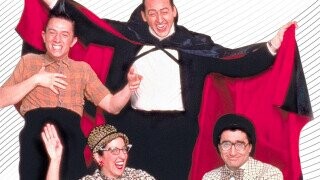How ‘SCTV’ Kept Canada’s Comedy Elite From ‘Saturday Night Live’

The early success of Saturday Night Live must have felt like validation for Second City. After all, half of SNL’s first stars were veterans of the company’s Chicago and Toronto stages, including John Belushi, Gilda Radner, Bill Murray and Dan Aykroyd. It could have been even more — Toronto’s John Candy, Dave Thomas and Joe Flaherty auditioned to replace Chevy Chase, a spot that went to Murray. On the other hand, “there was a little bit of jealousy,” admitted Thomas in Toronto Life’s oral history of the Canadian version of Second City. “SNL became a sensation so fast.”
According to Catherine O’Hara, “The whole thing inspired (Second City stage producer) Andrew Alexander to start SCTV. ‘Wait a minute — why are they going somewhere else? We could do it here!’”
Click right here to get the best of Cracked sent to your inbox.
Don't Miss
SCTV “came more out of a defensive response to SNL,” Alexander agreed in The Second City Unscripted: Revolution and Revelation at the World-Famous Comedy Theater. “I wanted to hold on to my Toronto cast and was deeply concerned that the U.S. networks were going to come calling.”
That wasn’t paranoia — Canadian Lorne Michaels had already raided Toronto twice. Why shouldn’t Canada enjoy the success of its own talents? So, in 1976, “it definitely seemed like now is the time, this kind of Second City comedy that had struck me so vividly when I first saw it onstage in 1973 can work on television,” remembered Eugene Levy. “So the idea of trying to put something together seemed like a good idea.”
The assembled cast would become nearly as legendary as the early SNL group: Candy, Levy, O’Hara, Thomas, Flaherty, Harold Ramis and Andrea Martin. (They’d soon be joined by Martin Short and Rick Moranis.) But like SCTV’s fictional television station, the real-life show had low budgets and questionable reach. At first, Second City Television aired sporadically on a regional network of small stations, going from monthly to biweekly to weekly episodes as the show found its footing.
Compared to the dominance (and budget) of Saturday Night Live, it didn’t feel like much of a competition. “Harold (Ramis) embraced the cheapness of SCTV,” Thomas told Toronto Life. “Eugene, Catherine and I were always moaning about how bad the sets looked and how shitty the props were. Harold would just chuckle and go, ‘That’s part of the charm!’”
“We couldn’t hope to be a splashy, slick network show,” said Ramis of the idea to set SCTV in “a really crummy local station. And I think we all said, ‘Well, yeah, that would be quite a relief. Let’s be really bad. We’ll do a lot of bad television and be local personalities.’ So it wasn’t going to be like SNL at all, and that was very liberating.”
The raggedy underdog success of the different incarnations of SCTV accomplished its mission, keeping Toronto’s most impressive comedy talents affiliated with Second City. But it could have gone another way. “At one point,” explained writer Paul Flaherty in The Second City Unscripted, “there was discussion of taking the entire SCTV cast and putting them on Saturday Night Live. But you know what? It would not have been as good.”
“There wasn’t that haphazard handicap that the Saturday Night Live people had to live with, and that’s doing it live,” said Levy. “If something’s not working, you can’t pull back and do take two. So you could do more ambitious things. You could do subtler things. And because of that, I think we were able to do a lot more higher-quality stuff.”